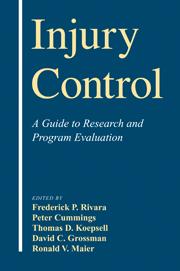Book contents
- Frontmatter
- Contents
- List of Contributors
- 1 An Overview of Injury Research
- 2 Classifying and Counting Injury
- 3 Measurement of Injury Severity and Co-morbidity
- 4 Data Linkages and Using Administrative and Secondary Databases
- 5 Rates, Rate Denominators, and Rate Comparisons
- 6 Data Collection Methods
- 7 Selecting a Study Design for Injury Research
- 8 Qualitative Methods in Injury Research
- 9 Randomized Trials
- 10 Cohort Studies in Injury Research
- 11 Case–Control Studies in Injury Research
- 12 Ecologic Studies
- 13 Case Series and Trauma Registries
- 14 Systematic Reviews of Injury Studies
- 15 Evaluating an Injury Intervention or Program
- 16 The Development of Clinical Decision Rules for Injury Care
- 17 Trauma Performance Improvement
- 18 Measuring Disability and Quality of Life Postinjury
- 19 Economic Evaluation of Injury Control
- 20 Ethical Issues
- Index
6 - Data Collection Methods
Published online by Cambridge University Press: 16 October 2009
- Frontmatter
- Contents
- List of Contributors
- 1 An Overview of Injury Research
- 2 Classifying and Counting Injury
- 3 Measurement of Injury Severity and Co-morbidity
- 4 Data Linkages and Using Administrative and Secondary Databases
- 5 Rates, Rate Denominators, and Rate Comparisons
- 6 Data Collection Methods
- 7 Selecting a Study Design for Injury Research
- 8 Qualitative Methods in Injury Research
- 9 Randomized Trials
- 10 Cohort Studies in Injury Research
- 11 Case–Control Studies in Injury Research
- 12 Ecologic Studies
- 13 Case Series and Trauma Registries
- 14 Systematic Reviews of Injury Studies
- 15 Evaluating an Injury Intervention or Program
- 16 The Development of Clinical Decision Rules for Injury Care
- 17 Trauma Performance Improvement
- 18 Measuring Disability and Quality of Life Postinjury
- 19 Economic Evaluation of Injury Control
- 20 Ethical Issues
- Index
Summary
Introduction
Injury research employs a wide array of approaches including descriptive epidemiology, analytic epidemiology, behavioral research, policy analysis, and program evaluation. For each approach, alternative methods are available to collect information about exposures, outcomes, or both. No method is ideal for all situations, but certain principles apply across studies. The study question, logistical, sampling, and budget issues determine the data collection method. In this chapter, we consider the suitability of various methods for different research questions. We address issues of feasibility, logistics of instrument design, and methods to enhance response rates and data quality.
Sampling
Collecting information from everyone in a large population can be prohibitively expensive. For this reason, investigators will often sample the members ofa study population.
The sample should represent the population to which the results are to be generalized and each person in the population of interest should have a calculable, nonzero probability of being selected. Achieving high response rates is important because of concerns regarding nonresponse bias (Lessler and Kalsbeek, 1992; Groves and Couper, 1998). Researchers often adjust or weight data so that the percent distribution of certain attributes of subjects (e.g., age, race, and sex) is equivalent to that in the population. This will reduce nonresponse bias to the degree that respondents within age–race–sex groups answer similarly to their nonrespondent counterparts.
Simple random sampling from a population has several advantages. First, the sample is easy to select when a list of all population members is available.
Keywords
- Type
- Chapter
- Information
- Injury ControlA Guide to Research and Program Evaluation, pp. 75 - 88Publisher: Cambridge University PressPrint publication year: 2000

